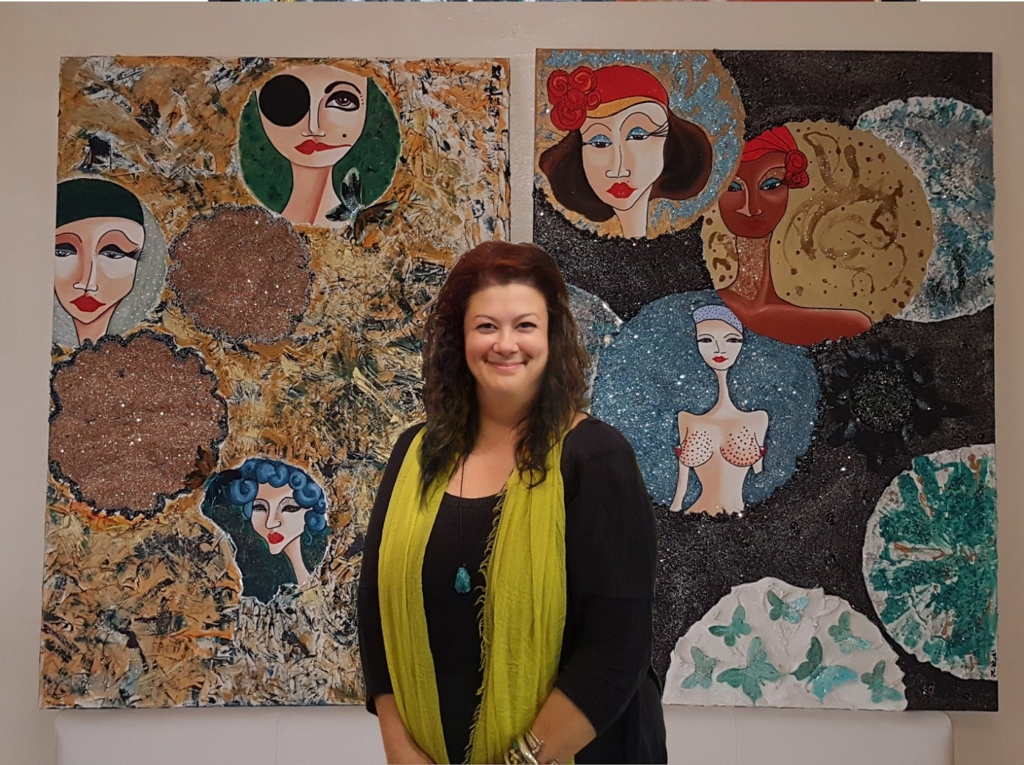
Malgrado gli studi in legge, l’esame di abilitazione superato e il lungo percorso di pratica professionale, la vocazione per l’arte della milanese Sara Pezzoni ha vinto sul lato più razionale della carriera di avvocato in cui la razionalità e la strategia avrebbero dovuto dominare sulla sfera emotiva. A seguito di un’approfondita riflessione decide dunque di scegliere di vivere la sua esistenza assecondando la creatività e il legame con le sensazioni, facendo della carriera artistica la sua unica professione. Il suo è un tipo di arte che ha bisogno di una struttura, un approccio di tipo realista seppur trasformato in un mondo apparentemente patinato in cui svela la sua tendenza a osservare un’interiorità spesso celata oltre l’immagine perfetta. Lo stile più affine alla sua natura, un po’ nostalgica nei confronti di un passato elegante e raffinato, un po’ pienamente consapevole che oltre quella cortina patinata e scintillante si nasconde un mondo più profondo in cui emergono le emozioni che non possono restare silenziose a lungo, è l’Art Déco, quello fondato e magistralmente interpretato da una delle pioniere della pittura del Novecento, una di quelle artiste con una forte personalità che sono state in grado di affermarsi in un mondo ancora appannaggio dell’uomo. Tamara de Lempicka fu tra le prime a spianare la strada all’arte al femminile che da quel punto in avanti ebbe nel tempo sempre più figure di rilievo. Sara Pezzoni dà un’interpretazione moderna di quello stile che ha affascinato gli anni Venti del Novecento, distaccandosi dalla pura estetica, legandosi a una forma più stilizzata ma al contempo andando oltre la sola apparenza, il puro culto della bellezza e dell’eleganza per scrutare le sue protagoniste nel profondo, svelandone luci e ombre, focalizzando l’attenzione sul dualismo vissuto nella società contemporanea tra il mostrarsi forti e l’essere consapevoli delle proprie fragilità, tra il credere in se stesse e il dover fare i conti con tutto ciò che non può essere controllato né ignorato, tra il preoccuparsi dell’esteriorità che nel vivere moderno deve essere sempre impeccabile e perfetta e il lasciarsi andare al dialogo con le proprie emozioni spesso in contrasto con l’immagine esterna. In qualche modo la Pezzoni mostra il suo pensiero filosofico sulla realtà attuale, un mondo in cui è richiesta, quasi come fosse un imperativo, un’attitudine alla superficialità che non può non entrare in contrapposizione con la natura umana, e in special modo con quella femminile, la quale ha bisogno invece di far sentire la sua voce emozionale. Ecco perché le bellissime ed eleganti donne ritratte dall’artista sono contraddistinte da lacrime, spesso solo su una metà del volto, come se la maschera indossata per conformarsi alle esigenze dell’ambiente circostante riuscisse a celare solo la metà della sua essenza mentre il suo lato più vero si manifestasse in modo inconsapevole. Nella tela Les dames bleues,
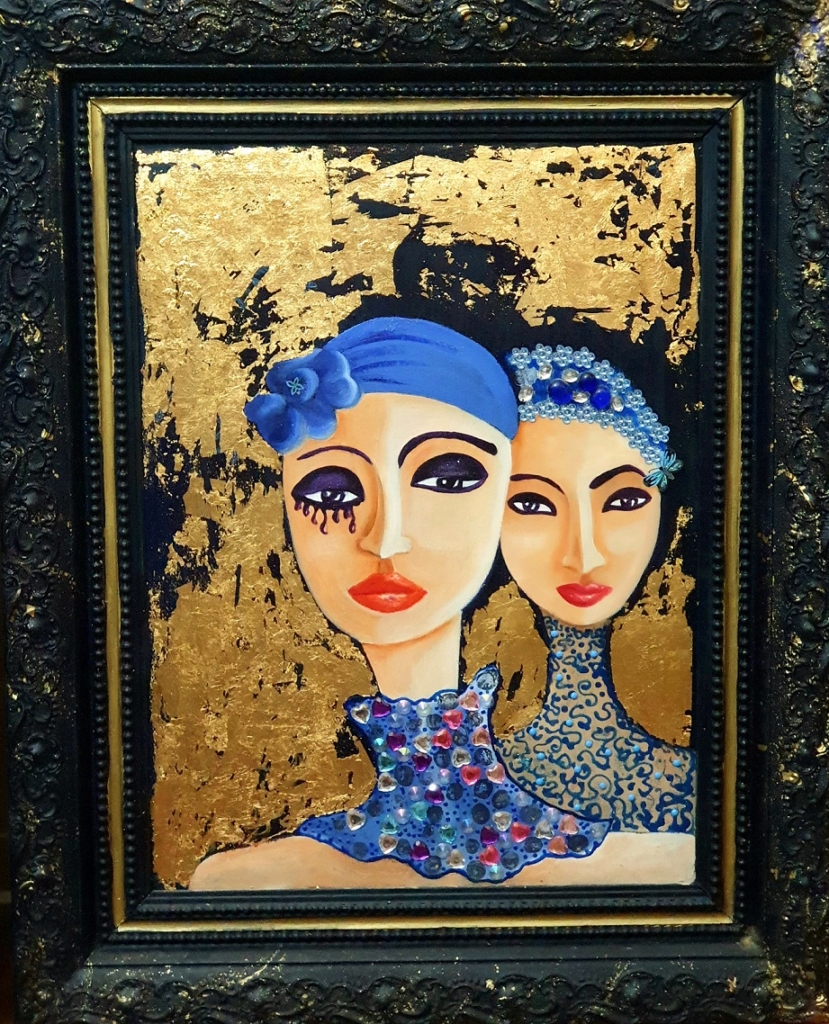
contraddistinte da colori glamour e da un opulento sfondo in foglia oro, la Pezzoni evidenzia la tristezza della ragazza in primo piano, come se tutto quell’inseguimento alla perfezione, quel doversi sentire costantemente in competizione con il mondo intero fosse un peso troppo grande per la sua sensibilità; l’altra, ipoteticamente una rivale, davanti alla quale con molta probabilità sente la fatica di dover essere sempre al meglio, la osserva, cercando di trovare il punto di debolezza che lei cerca di non rivelare. Eppure quella fragilità traspare dalle lacrime che sgorgano dall’occhio più protetto dallo sguardo dell’altra, infondendo nell’osservatore la sensazione che la perfezione non sia sufficiente a essere felici. E ancora in La bellezza del mondo
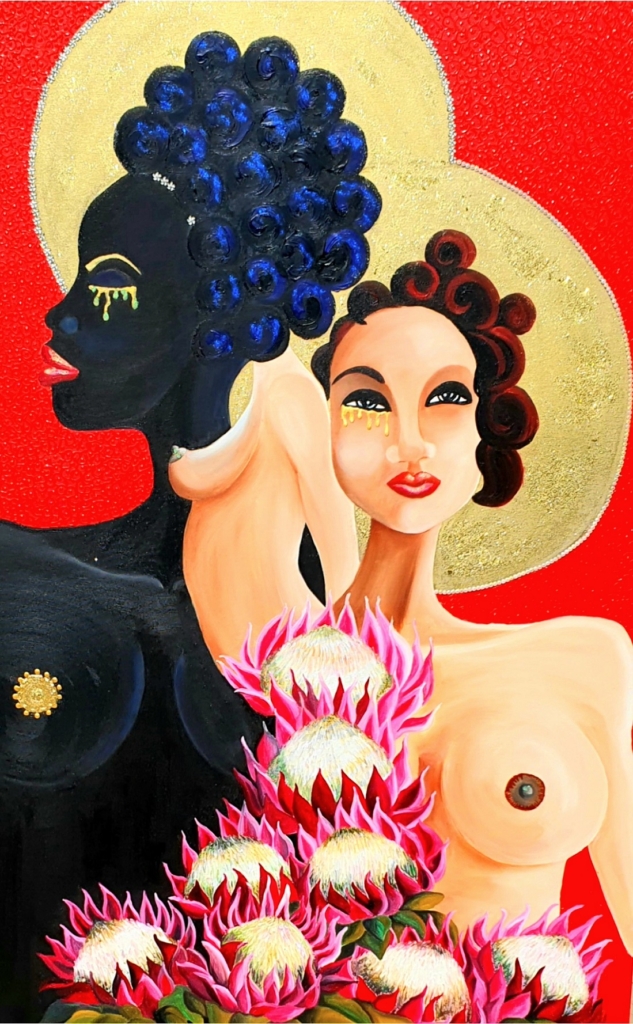
l’artista descrive la diversità di razza, religione, cultura, dunque la forma apparente, che pone però in un contesto naturalistico evidenziando quanto l’indole, la sensibilità, siano simili, vicine nel sentire che non conosce differenze perché vanno oltre tutto ciò che è visibile; in questo caso le lacrime sono forse riconducibili alla condizione della donna la quale a prescindere dalla società in cui cresce, più emancipata o ancora primitiva, deve comunque affrontare sfide, incertezze, difficoltà nell’affermarsi e nel far trasparire all’esterno quella sensibilità che spesso la induce a sentirsi incompresa, a trattenere tutto dentro di sé. Conosciamo meglio questa interessante artista attraverso le domande dell’intervista.
Sara, lei ha vissuto un dualismo professionale ed esistenziale, se consideriamo l’arte come un modo di essere, come è riuscita a conciliare i differenti approcci che li contraddistinguono? E qual è stata la molla che l’ha spinta a compiere la coraggiosa scelta di dedicarsi interamente alla carriera artistica?
Dopo gli studi in giurisprudenza e dopo anni di pratica forense, e il conseguimento del titolo di avvocato ho riflettuto a lungo su quale delle due professioni intraprendere. La scelta non è stata facile, da una parte anni di studi e di sacrifici, un master in diritto penale societario ed infine il titolo di avvocato; dall’altra la vita più bohemienne dell’artista. Scelta non facile, bilanciare, soppesare i vari aspetti positivi e negativi di entrambe. In tanti mi hanno detto che ho avuto coraggio ma forse la scelta inconsciamente l’avevo già compiuta quel tardo pomeriggio di fine novembre quando uscendo dall’aula di esame d’avvocato ho pianto a dirotto, un pianto liberatorio. La fine di una fase della vita.
Qual è il momento in cui si dedica all’arte nella sua giornata? Quanto è importante per lei esprimere tutto ciò che appartiene alla sua sfera più profonda? Crede sia essenziale, per l’artista ma anche per l’essere umano, riuscire a liberarsi ed evadere da un legame con la razionalità spesso necessaria nel complesso mondo contemporaneo? La creatività arriva di sorpresa e a volte anche a tarda sera. Mi ritengo privilegiata perché la mancanza di vincoli e lo studio in casa mi permettono di poter dar sfogo alla mia creatività in qualsiasi orario. Devo però confessare che il momento che prediligo è proprio la sera, quando il mondo esterno si ferma, i rumori svaniscono e rimango sola con la mia ispirazione e così mi perdo creando. Del resto ogni opera è un viaggio, è un perdersi, un vagare nell’anima, la solitudine credo che sia una componente importante per un’artista così come il dolore e la sofferenza perché sono stati d’animo da cui si trae la forza per creare, almeno per me è così. Ciascuno di noi ha un mondo dentro ma l’artista è fortunato perché riesce a farlo emergere, è in grado di tirar fuori quello che prova, quello che sente e quando riesce a comunicarlo al mondo si sente appagato. L’arte in fin dei conti non è altro che comunicazione e la personalità creativa ha attraverso di essa un strumento importante per comunicare, mettendo in risalto tutto ciò che vive e che prova attingendo alla sfera più profonda di se stesso, ecco perché dico che soprattutto il dolore e le esperienze negative sono espressioni di un sentire che l’artista riesce ad elaborare e trasmettere con le proprie opere. Tutti dovremmo riuscire ad esternare le nostre emozioni, a un artista risulta forse più facile ma di sicuro è liberatorio e serve anche per elaborare quello che la vita riserva.
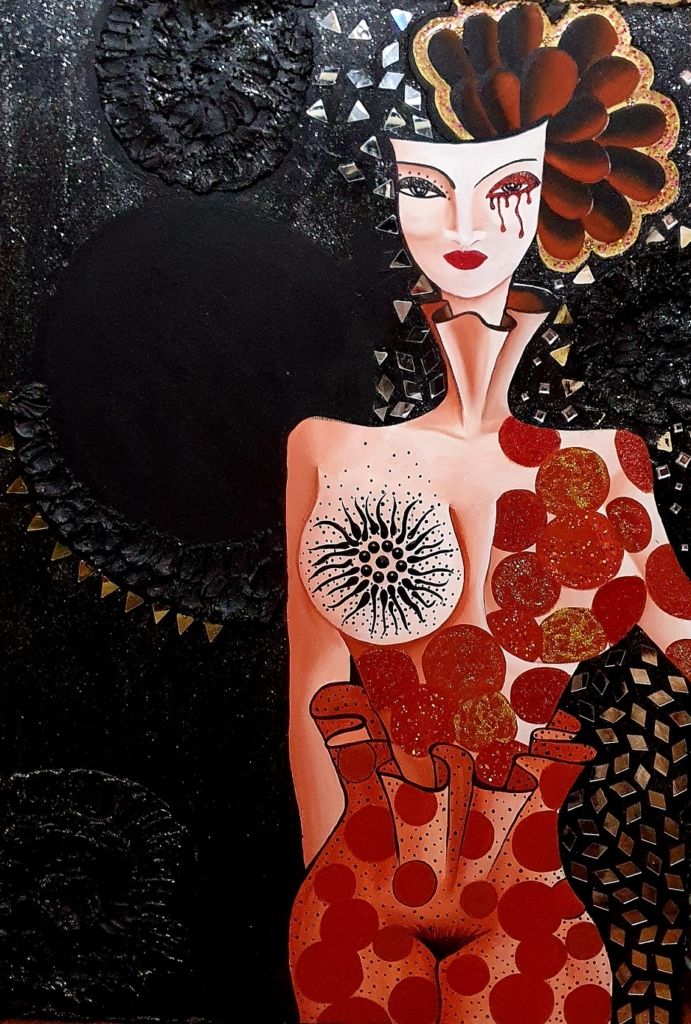
Le sue opere sono una celebrazione e un’esaltazione della donna, almeno a un primo sguardo, poi però lasciano fuoriuscire altre emozioni che svelano molto di più. Crede che la società attuale sia ancora tanto indietro nel riconoscere i talenti e le potenzialità del genere femminile? O forse il disagio che fuoriesce è dovuto a un’incapacità di fare i conti e accettare qualcosa che apparentemente rende la donna ancora debole?
Da sempre i soggetti delle mie opere sono le Donne uniche protagoniste delle mie creazioni, che a un primo sguardo sembrano ammiccare e sedurre complici anche i colori sgargianti, la nudità, la postura… ma sotto si cela un messaggio importante. Purtroppo anche se abbiamo conquistato molto c’è ancora da lottare, questo è riscontrabile ogni giorno in ogni parte del mondo; la parità di genere esiste solo sulla carta non nella concretezza della quotidianità. Troppe disuguaglianze sul lavoro, troppi preconcetti, stereotipi.
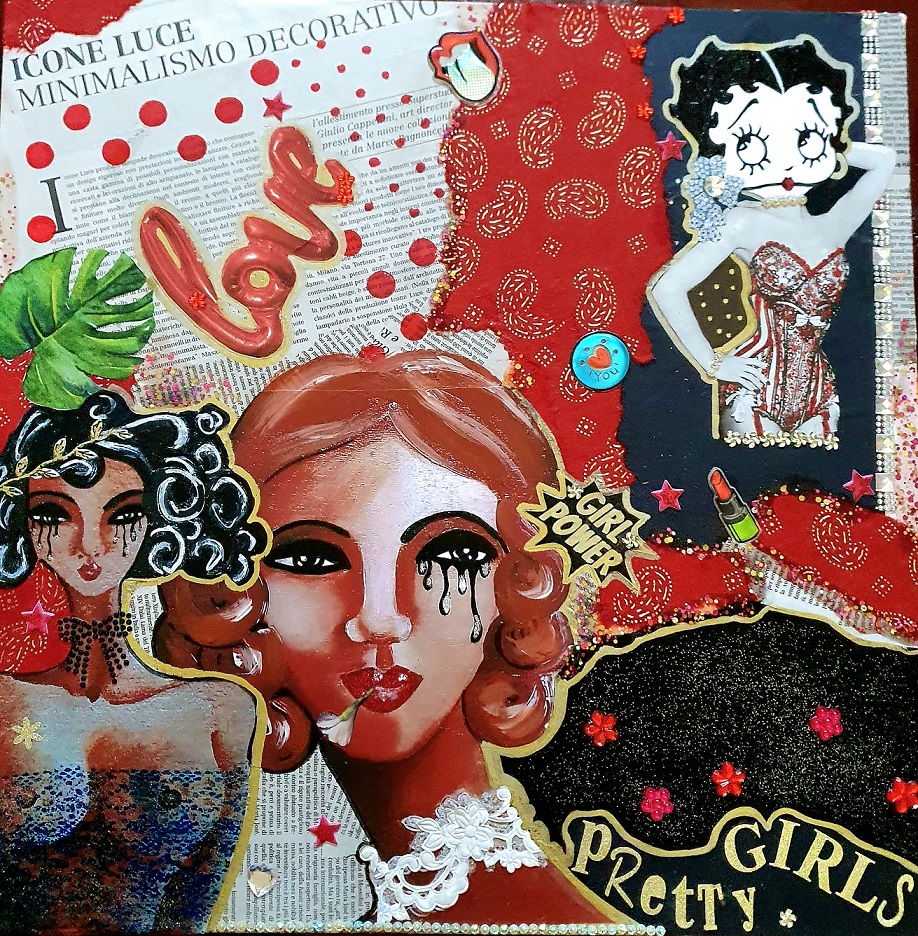
Le mie My Pretty Girls come le definisco affettuosamente sono un messaggio di ribellione a come il sentire maschile vorrebbe che fosse la Donna: provocante, sensuale, esteticamente perfetta, affascinante ma vuota. Una società che da una parte sostiene la parità di genere ma al contempo dall’altra opera in modo opposto. Quando si prenderà coscienza che il cambiamento avviene solo tramite l’educazione al rispetto fin da piccoli, allora forse le cose inizieranno a cambiare.
Come mai la scelta dello stile Art Déco? È un punto di arrivo il suo oppure ha sentito fin da subito di volersi orientare a questo linguaggio artistico?
Ho attraversato diverse fasi: i primissimi quadri avevano uno sfondo uniforme nero, poi mi sono spostata verso un periodo creativo in cui nello sfondo erano presenti elementi ornamentali. Il decorativismo non è stata una ricerca bensì è sorto spontaneo nel momento in cui ho avvertito l’esigenza di decorare gli sfondi delle mie opere che altrimenti mi apparivano scarne. Anche se devo confessare che gli anni Venti mi hanno sempre attratta per la moda femminile. Chissà forse il decorativismo in chiave Art Déco è inconsciamente un omaggio alla mia Nonna nata proprio nel 1920.
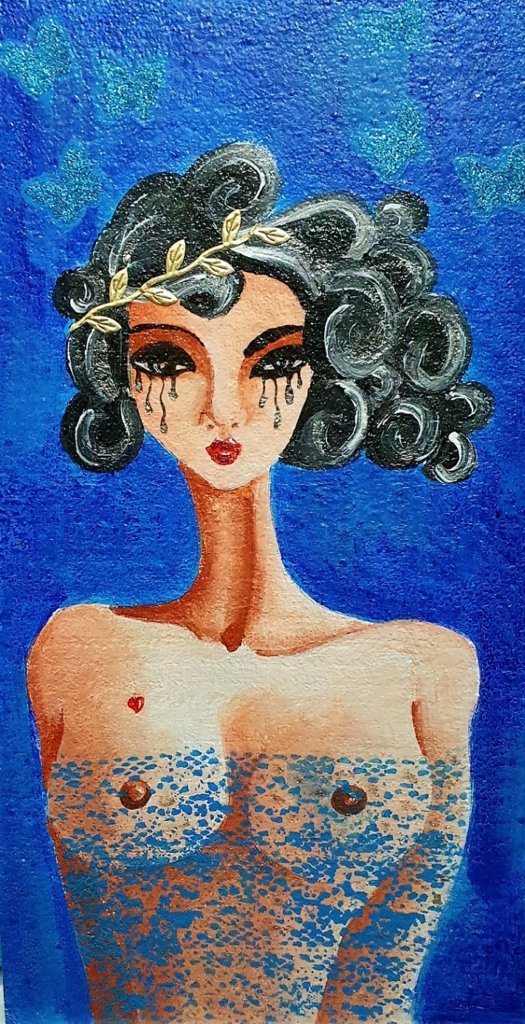
Lei ha al suo attivo la partecipazione a mostre collettive in Italia e all’estero – Parigi, Innsbruck, Montecarlo – e molte esposizioni personali. Ci racconta i suoi prossimi progetti?
Nei miei progetti futuri c’è sicuramente quello di dedicarmi a mostre personali, ma anche alla ricerca di qualcosa di nuovo, dal punto di vista artistico, poiché quando l’anima è agitata significa che c’è aria di cambiamento… vedremo dove mi porterà.
SARA PEZZONI-CONTATTI
Email: sarapezzoni.sp@gmail.com
Facebook: https://www.facebook.com/sarah.pezzoni
Marta Lock’s interviews:
Sara Pezzoni, a tale of the various aspects of Art Deco femininity
Despite studying law, passing her bar exam and a long professional practice, Milanese Sara Pezzoni’s vocation for art won out over the more rational side of a career as a lawyer in which rationality and strategy should have dominated over the emotional sphere. Following in-depth reflection, she therefore decided to choose to live her existence by indulging in creativity and the link with feelings, making the artistic career her only profession. Hers is a type of art that needs structure, a realist approach albeit transformed into an apparently glossy world in which she reveals her tendency to observe an interiority that is often concealed beyond the perfect image. The style most akin to her nature, a little nostalgic for an elegant and refined past, a little fully aware that beyond that glossy and glittering curtain hides a deeper world in which emotions emerge that cannot remain silent for long, is Art Deco, the one founded and masterfully interpreted by one of the pioneers of 20th century painting, one of those artists with a strong personality who was able to assert herself in a world still the preserve of man. Tamara de Lempicka was among the first to pave the way for female art, which from that point onwards had more and more prominent figures. Sara Pezzoni gives a modern interpretation of that style that fascinated the 1920s, detaching herself from pure aesthetics, linking herself to a more stylised form but at the same time going beyond mere appearance, the pure cult of beauty and elegance to scrutinise her protagonists in depth, revealing their lights and shadows, focusing attention on the dualism experienced in contemporary society between showing oneself strong and being aware of one’s own fragility, between believing in oneself and having to come to terms with all that cannot be controlled or ignored, between worrying about the exterior, which in modern life must always be impeccable and perfect, and letting oneself go in dialogue with one’s own emotions, often in contrast with the external image. In a way, Pezzoni shows her philosophical thoughts on today’s reality, a world in which an attitude of superficiality is required, almost as if it were an imperative, that cannot fail to contrast with human nature, and especially with female nature, which instead needs to make its emotional voice heard. This is why the beautiful and elegant women portrayed by the artist are marked by tears, often only on one half of the face, as if the mask worn to conform to the demands of the environment could only conceal half of her essence while her truer side is unconsciously manifested. In the canvas Les dames bleues, distinguished by glamorous colours and an opulent gold-leaf background, Pezzoni highlights the sadness of the girl in the foreground, as if all that pursuit of perfection, that having to feel constantly in competition with the whole world was too great a burden for her sensitivity; the other, hypothetically a rival, in front of whom she probably feels the fatigue of always having to be at her best, observes her, trying to find the point of weakness that she tries not to reveal. Yet that fragility shines through in the tears that flow from the eye most protected from the other’s gaze, instilling in the observer the feeling that perfection is not enough to be happy. And again in La bellezza del mondo (The Beauty of the World), the artist describes the diversity of race, religion, culture, thus the apparent form, which she places in a naturalistic context, however, highlighting how much the temperament, the sensitivity, are similar, close in feeling that knows no differences because they go beyond all that is visible; in this case, the tears are perhaps traceable to the condition of women, who, regardless of the society in which they grow up, whether more emancipated or still primitive, must nevertheless face challenges, uncertainties, difficulties in asserting themselves and in revealing to the outside world that sensitivity that often leads them to feel misunderstood, to keep everything inside. Let us get to know this interesting artist better through the interview questions.
Sara, you have experienced a professional and existential dualism, if we consider art as a way of being, how did you manage to reconcile the different approaches that distinguish them? And what was the driving force that prompted you to make the courageous choice to devote yourself entirely to an artistic career?
After studying law and after years of practising law, and obtaining the title of lawyer, I thought long and hard about which of the two professions to pursue. The choice was not easy, on the one hand years of studies and sacrifices, a master’s degree in corporate criminal law and finally the title of lawyer; on the other the more bohemian life of an artist. Not an easy choice, balancing the various positive and negative aspects of both. Many have told me that I was courageous, but perhaps unconsciously I had already made the choice that late afternoon at the end of November when I came out of the bar exam room and cried my eyes out, a liberating cry. The end of a phase of life.
What is the moment you devote to art in your day? How important is it for you to express everything that belongs to your deepest sphere? Do you think it is essential, for the artist but also for the human being, to be able to break free and escape from a bond with rationality that is often necessary in today’s complex world?
Creativity comes by surprise and sometimes even late at night. I consider myself privileged because my lack of constraints and my home studio allow me to give vent to my creativity at any time. However, I must confess that my favourite time is in the evening, when the outside world stops, the noises fade away and I am alone with my inspiration and thus lose myself creating. After all, every work is a journey, a wandering in the soul, solitude I believe is an important component for an artist as well as pain and suffering because they are states of mind from which one draws the strength to create, at least for me it is like that. Each one of us has a world inside, but the artist is lucky because he is able to bring it out, he is able to get out what he feels, what he hears, and when he is able to communicate it to the world he feels fulfilled. Art is ultimately nothing more than communication and the creative personality has through it an important tool to communicate, highlighting everything he lives and feels by tapping into the deepest sphere of himself, that’s why I say that especially pain and negative experiences are expressions of a feeling that the artist is able to process and transmit with his artworks. We should all be able to externise our emotions, for an artist it is perhaps easier but it is certainly liberating and also serves to process what life holds in store.
Your artworks are a celebration and glorification of women, at least at first glance, but then they let out other emotions that reveal much more. Do you think today’s society is still lagging behind in recognising the talents and potential of the female gender? Or perhaps the unease that leaks out is due to an inability to come to terms with and accept something that apparently still makes women weak?
The subjects of my artworks have always been Women, the only protagonists of my creations, who at first glance seem to wink and seduce, thanks also to the bright colours, the nudity, the posture… but underneath there is an important message. Unfortunately, even though we have achieved a lot, there is still a struggle to be fought for, and this can be seen every day in every part of the world; gender equality exists only on paper, not in the concreteness of everyday life. Too many inequalities at work, too many preconceptions, stereotypes. My Pretty Girls, as I affectionately call them, are a message of rebellion against how male feeling would like a woman to be: provocative, sensual, aesthetically perfect, fascinating but empty. A society that on the one hand supports gender equality but at the same time operates in the opposite way. When people become aware that change only comes through education in respect from an early age, then perhaps things will start to change.
Why the choice of the Art Deco style? Is it a point of arrival for you or did you feel you wanted to move towards this artistic language right from the start?
I went through different phases: the very first paintings had a uniform black backdrop, then I moved towards a creative period in which there were ornamental elements in the background. Decorativism was not a search but arose spontaneously when I felt the need to decorate the backgrounds of my artworks that otherwise appeared bare. Although I must confess that the 1920s have always attracted me to women’s fashion. Who knows, maybe the Art Deco decorativism is unconsciously a homage to my grandmother who was born in 1920.
You have to your credit the participaion in group exhibitions in Italy and abroad – Paris, Innsbruck, Monte Carlo – and many solo exhibitions. Can you tell us about your next projects?
In my future plans there is definitely to devote myself to personal exhibitions, but also to the search for something new, from an artistic point of view, because when the soul is agitated it means that there is an air of change… we will see where it will take me.
Instagram: https://www.instagram.com/sarahpezzoni.sp/
